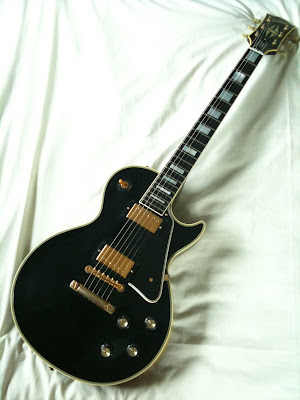I just installed the NVS Resomax bridge on my Standard. This bridge is something to me that's very significant in terms of an upgrade.
Graphtech claims:
The new ResoMax Harmonic Bridge System is designed to maximize harmonic content and richness in every note. All of our bridges and tailpieces are made from harmonically rich ResoMax alloy which allow the natural sound of your guitar to shine through. Exclusive to the ResoMax system, the AutoLock locking feature magnetically secures your bridge and tailpiece at all times without tools to use or lose, making restringing simple and quick.
The ULF (Ultra-Low-Friction) Saddles are designed to maximize harmonic content and richness in every note, retain the bite of a metal saddle, dramatically reduce string breakage and make restringing a breeze!
So. What did this bridge do for my guitar? How did it sound after fitment? Honestly? I couldn't hear any difference at all in terms of tone.
That's actually the most significant bit, and it's what made me the happiest.
Why? Because graphite saddles normally do dull your tone a bit. These ULF saddles, have the self-lubricating component, but does not affect your tone. In fact, it would seem that what they advertise as "retaining the 2Khz spike in metal saddles" seems to be true. FWIW, I kept the same strings on that I had before the swap. So nothing about new strings changing/preserving that tone.
However, I also didn't really notice significant increase in harmonic content. That could partially be because I'm already running a lightweight tailpiece, and didn't use the Resomax tailpiece. My guitar was already harmonicaly rich, and with PAF clones and low gain, I can't say that there was much increase. But however, with high-gain, harmonics seemed to sustain a bit longer and fuller, though it was already quite good at that in the past.:applause: I can't say for sure, because I didn't really measure, and harmonics are a result of many more things than just the saddles.
So what I did probably get at the end of the day, was a well made bridge, that replaced my stock Nashville bridge, improved the smoothness of the saddles, and didn't alter the tone. No sustain loss either, and that was another worry pacified.
I say again, this guitar had very good tone to begin with, so I was actually afraid that the tones would have been altered significantly. I did want the "greasy" bit from the saddles, and I think I got that. The guitar did seem a bit louder and richer acoustically, but when plugged in, I couldn't hear any difference compared to before the swap.
So all in all, I'd say this was probably a worthwhile swap, and while it was probably not what an ABR-1 would have delivered in terms of tone, it was definately something that I wanted, as it didn't change the already sweet tones on this guitar.
GRX... new colours
-
*Ibanez*'s April highlight is actually a trio of GRX in three new colours.
That's right, colours are new, the GRX40 had been a Gio mainstay for a
while....
1 day ago





